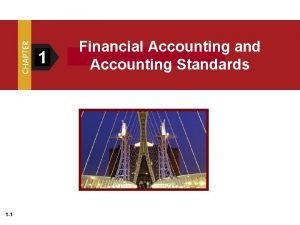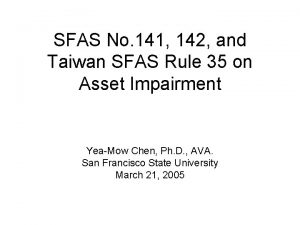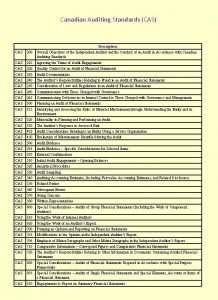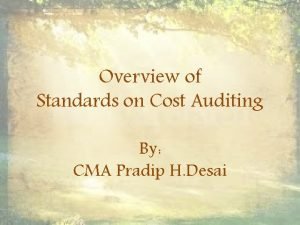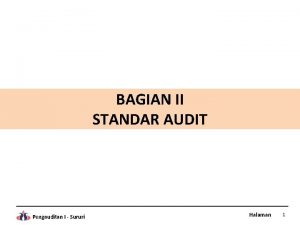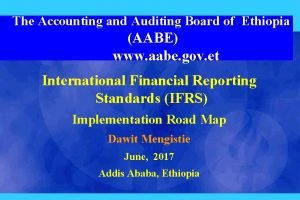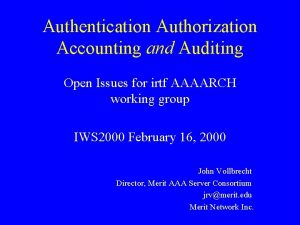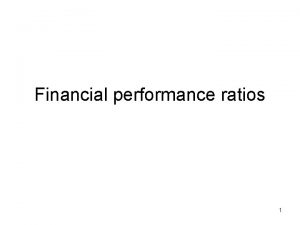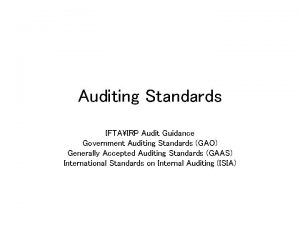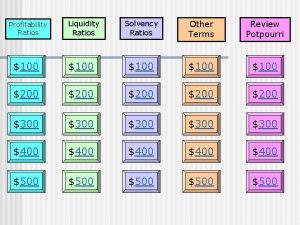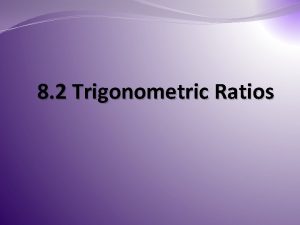AUDITING ACCOUNTING STANDARDS AND FINANCIAL RATIOS I ACCOUNTING












- Slides: 12

AUDITING ACCOUNTING STANDARDS AND FINANCIAL RATIOS

I. ACCOUNTING STANDARDS – INTRODUCTION AND OBJECTIVES • Written documents, consisting authoritative pronouncements, issued by Government or Regulatory body • Standardize diverse accounting policies • Add reliability to the Financial Statements • Facilitate intra – company and inter company comparisons • Eradicate baffling variation in treatment of accounting aspects

II. ESSENCE AND METHOD OF ACCOUNTING: • UNIVERSAL ACCOUNTING PRINCIPLES: - Double Entry Accounting (Debits (+) = Credits (-)) Assets = Liabilities + Equity Change in Equity is a result of Revenues and Expenses (Profit or Loss) • CHARACTERISTICS OF FINANCIAL ACCOUNTING: - Accounting identifies, measures and communicates financial information - This information is about economic entities - Information is communicated to interested parties such as investors, creditors, unions and governmental agencies.

III. INTERNATIONAL ACCOUNTING STANDARDS – WHY NEEDED • Accounting principles and procedures vary widely from country to country • Multinational companies incur additional costs of preparing different reports for use in different countries • Accounting reports lack consistency • Financial analysis is more costly and less efficient • Lack of comparability causes the credibility of accounting to suffer • It does not make economic sense for every country to incur the enormous cost of developing its own national standards

IV. DISTINCTION BETWEEN ACCOUNTING AND AUDITING • Accounting is the recording, classifying, and summarizing of economic events for the purpose of providing financial information used in decision making. • Auditing is determining whether recorded information properly reflects the economic events that occurred during the accounting period.

V. TYPES OF AUDITS • Operational Audit: - Involves evaluation of any part of an organization’s operating efficiency and effectiveness. - Not limited to accounting areas • Compliance Audit: - Determine whether the auditee has complied with specific procedures, rules, or regulations set by some higher authority. • Financial Statement Audit: - Determine whether overall financial statements are stated in accordance with specified criteria. - Generally accepted accounting principles are normally the criteria, although other basis of accounting are at times used.

VI. TYPES OF AUDITORS • External or Independent Auditors – CPAs are the only group permitted to provide financial statement audits. Such audits are required of all publicly traded companies. • General Accounting Office Auditor – works for the Comptroller General who reports to and is solely responsible to Congress. They audit various governmental bodies. • Internal Revenue Agents – evaluate taxpayer compliance with tax laws. • Internal auditors – Auditors who are employees of the companies they audit.

VI. AUDIT REPORT • The standard audit report consists of 7 parts: - Report title – Must include the word independent - Audit report address – Customary to address to board of directors and stockholders to demonstrate independence - Introductory paragraph – States that an audit has been performed; identifies the financial statements and appropriate dates; states that the financial statements are the responsibility of the entity’s management. - Scope paragraph – States that auditor followed GAAS or PCAOB standards and indicates that the audit only provides reasonable assurance. - Opinion paragraph – Communicates the results of the audit. - Name of CPA firm or practitioner. - Audit report date showing last day of field work. Auditor is held accountable only through this date

VIII. FINANCIAL RATIOS – DEFINITION AND PURPOSE • The relationship between two accounting figures expressed mathematically is known as financial ratio • What is the purpose of analysis of financial ratios: – It is for a meaningful study of information in the financial statements – Ascertaining overall financial position of a business organization - Interpretation of key information in the financial statements • - Objectives: Assess credit risk profile of the borrower Establish sound well defined credit granting criteria Assess utilization of credit facility Ensure safety of bank funds

IX. LIQUIDITY RATIOS • Current Ratio = Current Assets/Current liabilities. A liquidity ratio that measures a company's ability to pay short-term obligations. The ratio is mainly used to give an idea of the company's ability to pay back its shortterm liabilities (debt and payables) with its short-term assets (cash, inventory, receivables). The higher the current ratio, the more capable the company is of paying its obligations. A ratio under 1 suggests that the company would be unable to pay off its obligations if they came due at that point • Quick ratio = (Current assets – Inventories)/Current liabilities. Also known as the "acid-test ratio" or the "quick assets ratio". An indicator of a company's short-term liquidity. The quick ratio measures a company's ability to meet its short-term obligations with its most liquid assets. The higher the quick ratio, the better the position of the company.

X. EFFICIENCY RATIOS • Profit margin = Net income/Revenues. It measures how much out of every dollar of sales a company actually keeps in earnings. Profit margin is very useful when comparing companies in similar industries. A higher profit margin indicates a more profitable company that has better control over its costs compared to its competitors. • Return on Equity = Net profit/Shareholder`s equity. The amount of net income returned as a percentage of shareholders equity. Return on equity measures a corporation's profitability by revealing how much profit a company generates with the money shareholders have invested. Does not include preferred stocks. • Return on Assets = Net Income/Total assets. An indicator of how profitable a company is relative to its total assets. ROA gives an idea as to how efficient management is at using its assets to generate earnings.

XI. OTHER RATIOS • Interest cover – shows whether funds are available to repay expenses on company`s debt. • Debt/Equity ratio is a. k. a. gearing (UK) or leverage (US). Compares the amount of debt to company`s own capital. • Earnings per share (EPS) = (Net income – Dividends on preferred)/ Average number of outstanding shares. The portion of a company's profit allocated to each outstanding share of common stock. Earnings per share serves as an indicator of a company's profitability. • Price/Earnings (P/E) ratio = Market value per share / Earnings per share. A valuation ratio of a company's current share price compared to its pershare earnings. EPS is usually from the last four quarters (trailing P/E), but sometimes it can be taken from the estimates of earnings expected in the next four quarters (projected or forward P/E).
 How do auditing standards differ from auditing procedures
How do auditing standards differ from auditing procedures Financial accounting and accounting standards chapter 1
Financial accounting and accounting standards chapter 1 Sri lanka accounting standards
Sri lanka accounting standards Auditing computer based information system
Auditing computer based information system Accounting rules
Accounting rules Sfas 142
Sfas 142 Cas 805
Cas 805 Cost auditing standards
Cost auditing standards Pcaob auditing standards
Pcaob auditing standards Aabe ifrs
Aabe ifrs Authentication authorization accounting and auditing
Authentication authorization accounting and auditing Under armour financial ratios
Under armour financial ratios Healthcare industry financial ratios
Healthcare industry financial ratios




